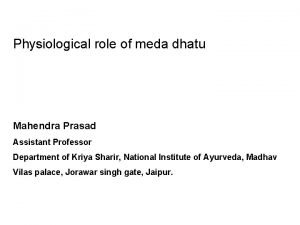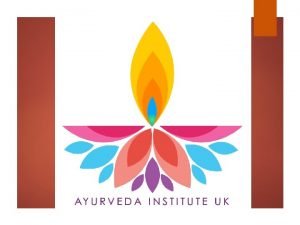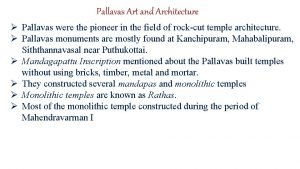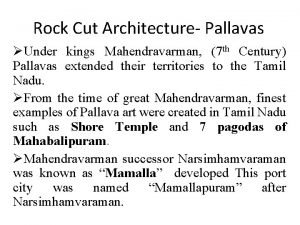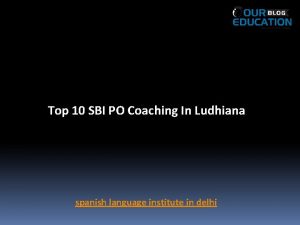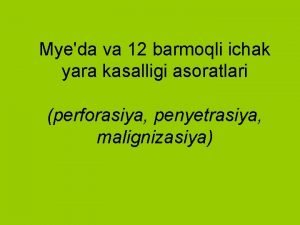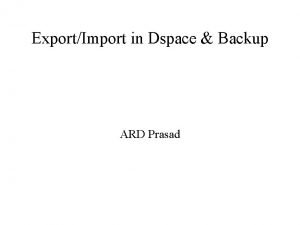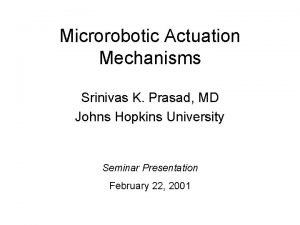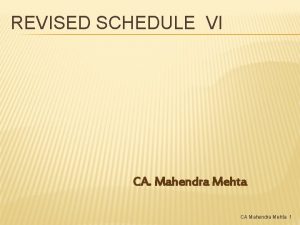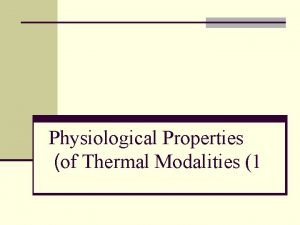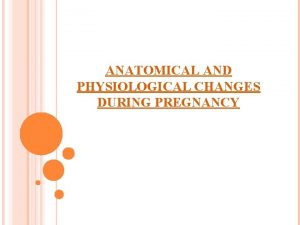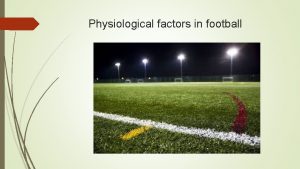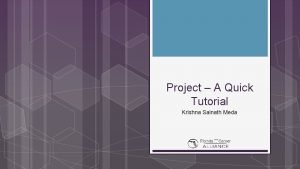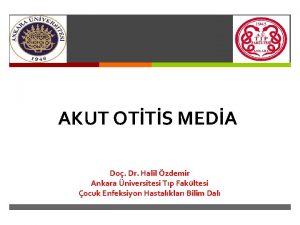Physiological role of meda dhatu Mahendra Prasad Assistant


























- Slides: 26

Physiological role of meda dhatu Mahendra Prasad Assistant Professor Department of Kriya Sharir, National Institute of Ayurveda, Madhav Vilas palace, Jorawar singh gate, Jaipur.

contents • Vyutpatti • Nirukti • Synonyms • Panchbhautikatva • Location/place • Properties • Functions • Pramana • Physiology of medovaha srotas • Formation of meda dhatu • Vriddhi lakshana • Kshaya lakshana • Ashray ashrayi bhav • Medasaar purush lakshana

Vyutpatti 1. Grammatical Ground: ञ म द Dhatu, ������� meaning in the sense of oleation सनहन .

Nirukti • मदयत सनहयत इत मद । (Amarkosh) Attraction softness affections • सन हयत पर त कर त त सनह । Piyush commentary on UNadikosh 1/159 positive relation affection softness with physically and mentally

Synonyms • मदसत वप वस । अमरक श २/६/६४ • Vapavivarmedaso heti. Shabdakalpdruma Vol 4; p 266





Pramana • दव मदस । (च. श . ७/१५) • तरय वस य • एक मजज य • Vasa is updhatu of mans dhatu and lies near, it is not movable. , ,

Physiology of medovaha srotas • Medovaha Srotas. • मद वह दव तय रमल कट वकक च। (स. श . १/१८) • मद वह न सर तस वकक मल वप वहन च। (च. व . ५/८) • Medovaha Srotas • meda dhatwagni • The fat cells are held together mainly by the network of the capillary blood Poshaka Dhatu & Mala. vessels and distributed. Medovaha Srotas are the channels through which the Poshaka or Asthayi Medo Dhatu circulates in the whole body with Rasa & Rakta thereby nourishing the Sthayi Medo Dhatu.


Vapavahana • Koshthanga • Snehavartika and tailvartika • According to Dr. Ghanekar omentum maximum capacity to store the Meda. • वप वहन वप उदरसथ य म हरजन सतलवरत कत । सन गधवरत क च० व ० ५/८

kati • fat gets accumulated. • gets observe externally. Mamsa • 3 rd dhatu mula of Medovaha Srotas.

Formation of medodhatu • maternal bhava. • Medodhatu is nourished by three ways of mechanism named as * ksheer dadhi nyay, * kedari kulya nyay * khalekapota nyaya. *ekkaldhatuposhana paksha • Panchabhautika structure (Prithvi & Jala) Medodhatu

Flow chart of dhatuposhana karma Ksheer dadhinyaya Panchabhautik ahara Jatharagni Saar part (Annarasa) Mala part (mutra/urine, purish/stool) Rasagni Raktagni Mamsagni Medagni M Mala (Sweda) Sthula (Medadhatu) Sukshma. Amsha

• Kedarikulyanyaya Ahar (Panchbhautik) Pachakagni Prasad (Ahar Rasa) Kitta (Mutra, Purisha) Medadhatu Medagni Sara Upadhatu Medashaya Kitta

• Khale-kapot nyaya: Mamsagni Ahar Rasa (Khalihana) Medagni Sara Mamsa dhatu & Upadhatu Kitta Khamala Sara Meda dhatu & Upadhatu Kitta Sweda

Medo dhatu vriddhi lakshana Increased Medodhatu • The whole body becomes oily • Abdominal trunk & flanks become obese • Individual will suffers from cough and asthma • Perspiration by slight or very light exertion and smell is not good. • मद सन गध डगत मदरप रशरववदध क सशरव स द न द रगनधय च। (स. स. १५/११)

• prameha poorvarup, • complication of sthaulya, • disease of kapha, rakta and mans. • Sthaulya people will have least life span, • less activity • loss of libido or difficulty in sexual act, • weakness, foul smell, excess perspiration • hunger and thirst. • It scientifically proved that obese people have multisystem diseases. • परमहपरवरप सथ लय पदरवशच नयरप शलषमरकतम सव क रपर यरमद । • अत सथलसय द रबलय त वद यष द रगनधय प प स त य गशचत अ० स० स० ११/११ हर स सवद ब ध भवनतयषट जव पर ध कचछरवयव यत कषदत म तर द ष | (च. स. २१/३(

Medo dhatu kshaya lakshana • Joints of body become dry and painful • Unctuousness of eyes and fecal matter is due to mala of majja dhatu. • Sensation loss at pelvic region, • Plihavriddhi (splenomegaly) and reduction of body mass. • Demanding more unctuous & heavy diet. • sandhisunyata • Body becomes lean and thin specially abdominal region. • मद कषय मदरम स • सध न मदस पल ह भ वदध पर रथन सफटन कष ण सनध शनयत र कषय च । (स. स. १५/१३) गल न रकषण र य स तनतव च दरसय च। एव च। लकषण

Ashray ashrayi bhav • The homologous character is present in dushya and dosh. • There is kapha in ashraya and meda is ashrayi. • Location of kapha lies in Meda dhatu. • उर श र गर व शलषमसथ न न • परव णय म शय …. मदशच च० ��� २०/८ Samanya and special principles ---- three components as dravya, guna and karma. Guna Meda Kapha Snigdha Alpepicheshtite shwas Shwas, kas Guru Alpacheshta Alasya, gaurava Manda Atinidra, alasya Atinidra Sandra Sphika, stanodarlambanam Sthaulya Upchita, paripurnasarvanga

• Vitiation of kapha and meda are same as diet and external factors. • Dravya like ghee, oil and other substances similar to meda are dravya samanya and opposite to that is dravya vishesh such as yava and bajara. • The quality of both kapha and meda are nearly same as snigdh, sheet, guru, manda, shlakshna, sthir, Sandra, pichchhil and mridu. • medo vriddhi is homologous to shleshmavikar. • ������������� �������������� �� /�� • On the basis of karma, meda has sneh, bandh, dridhatwa and mriduta same as function of kapha is sneha, bandha, sthiratvam and heaviness. • weaning of kapha leads to shleshmashaya shunyata, rough, sandhisaithilya, bhrama (dizziness) and same as deficit of medadhatu creates the symptoms of swapanakati, plihavriddhi (spleenomegaly), weaning of organs and shosh (cachexia).


Medo sara purusha • Lustrous skin • Deep & appealing voice • Shiny and lustrous eyes, kesh, loma, nails, teeth and lips. • The urine & faeces are soft, semisolid and oily. • Person achieves wealth, richness, happiness, feeling of wellbeing, and an offering of cordiality, simplicity, soft, tender and obedient. • Heavy body and lethargies have fewer tendencies to perform the work (Su. sha. 9). • वरणसवरनतरकशल मनखदनत षठमतरपर षष सनह मद स र ण म व शषत | व ततशवरयसख पभ गपरद न नय रजव सकम र पच रत च चषट || (च. व . ८/१०६) स स रत

 Functions of meda *
Functions of meda * Udumbara kushta
Udumbara kushta Bank coaching in dehradun
Bank coaching in dehradun Mahendra kumar fiji
Mahendra kumar fiji Pallavas art and architecture
Pallavas art and architecture Mahendra style of architecture
Mahendra style of architecture Mahendra institute ludhiana
Mahendra institute ludhiana Role of a teaching assistant
Role of a teaching assistant Meda yara kasalligi
Meda yara kasalligi Niko casu meda ne ispi
Niko casu meda ne ispi Railmed
Railmed Meda shirasi tekshirish
Meda shirasi tekshirish Meda elastica
Meda elastica Darvoza venasi
Darvoza venasi Pollock blue poles
Pollock blue poles Ovqat hazm qilish tizimi fiziologiyasi
Ovqat hazm qilish tizimi fiziologiyasi Psalam zdesna ti je kraljica u zlatnoj odjeći
Psalam zdesna ti je kraljica u zlatnoj odjeći Statuses and their related roles determine the structure
Statuses and their related roles determine the structure Azure web role worker role example
Azure web role worker role example Krappmann schaubild
Krappmann schaubild Ard prasad
Ard prasad Dr kedar prasad micro daily
Dr kedar prasad micro daily Astha prasad
Astha prasad Prasad raghavendra
Prasad raghavendra Lawrence prasad
Lawrence prasad Srinivas prasad md
Srinivas prasad md Rachit prasad
Rachit prasad
